Categories: Featured Articles » Interesting Facts
Number of views: 2658
Comments on the article: 0
Thunderstorm and lightning: what you need to know about it
For an inexperienced layman who was fortunate enough to never be struck by lightning in his life, a thunderstorm appears to be just a flash of light and peals of thunder. In fact, lightning is a rather complex natural phenomenon.
First, from the cloud, it rapidly falls down to the ground "leader". The leader is the starting part of the lightning discharge. Having walked about a hundred meters, the leader slows down to accumulate energy, gain a charge, then he moves further, turns away from space with air of greater resistance - where there is less resistance, passes the following stages, and in the end goes all the way, which can reach tens of kilometers .
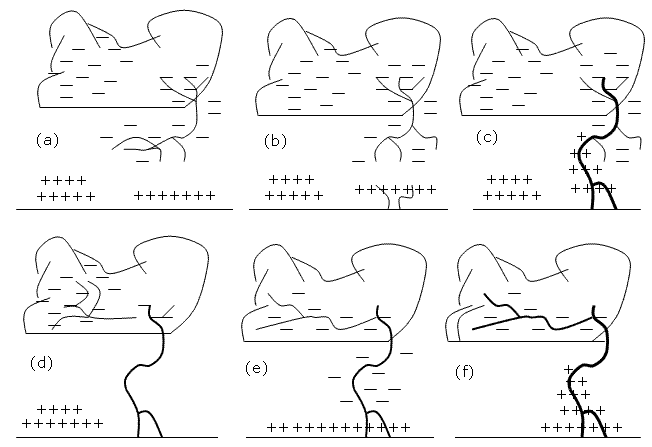
Moving ever closer to the earth, and already at a distance of several tens of meters from its surface, the leader causes an oncoming (induced) electric discharge of the opposite sign from some natural or artificial hill.
This oncoming discharge is connected with the leader, and at that moment a conductive current trunk of linear lightning is formed, along which forward and reverse moving charges form a current of tens and hundreds of thousands of amperes. But in appearance this is just a flash, existing in the case of linear lightning for a thousandth of a second. And if lightning lives a tenth of a second - such lightning can be considered lightning - long-lived.
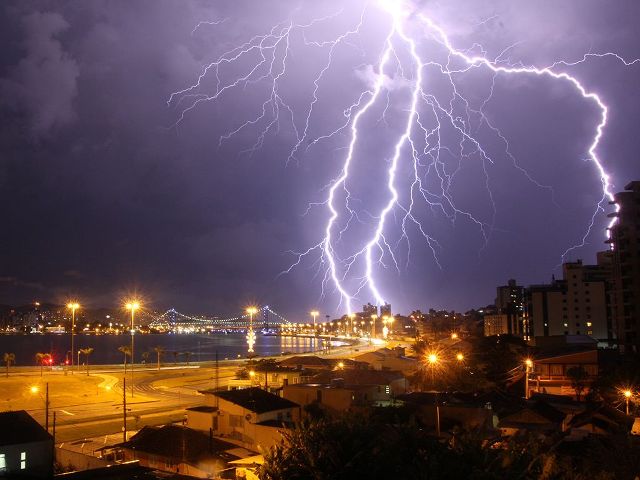
Where and why does lightning strike
But how does lightning choose the place where she should strike? The fact is that when the leader of the lightning approaches the surface of the earth, directly on the surface of the earth, in a place under the leader, the electric field intensifies and rapidly accumulates induced electric charge.
Finally, in the place where the induced charge has accumulated the most, and where the electric field strength was higher - there comes the critical moment - it happens air breakdown.
Typically, a breakdown occurs in an object that rises above the surface of the earth, since the tip or protrusion of the charge accumulates most. So it is considered. However, the lightning leader moves very quickly, primarily choosing a site with higher electrical conductivity, less electrical resistance.
Wet soil in the place of occurrence of metal ores has a higher electrical conductivity compared to, say, dry sand, which has poor conductivity, which prevents the induced charge from moving toward the leader. Therefore, lightning can go around a high sandy hill, choosing instead a trickle, abundantly moisturizing the lowland. At such moments, it seems that lightning has chosen a place to strike lower than it should.
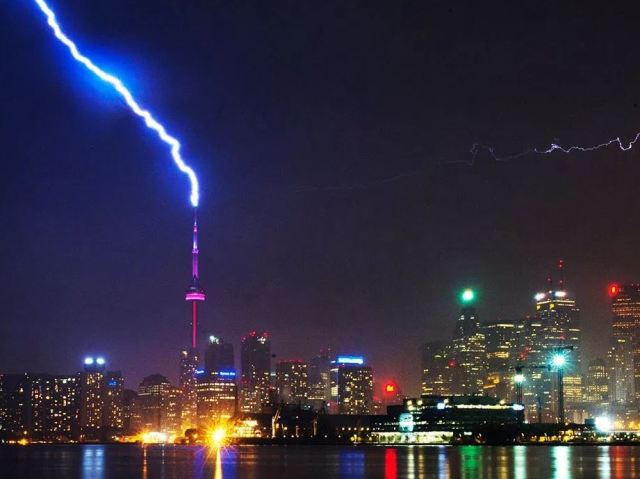
To reduce the likelihood of lightning getting directly into a building, into a tower or into a power line, these structures are equipped with special protective equipment - lightning rods.
Lightning rods are grounded metal pins mounted vertically and pointed from above. The grounding of the pin is carried out very efficiently, with the help of metal sheets of a large area, which are buried in the ground at a level where there is always sufficient humidity.
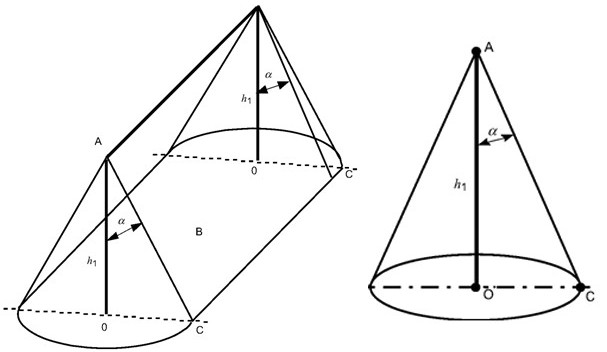
Suppose a lightning conductor has a height h1, then it will reliably protect objects inside the cone with the angle of the alpha forming and the radius of the base of the OS. This means that almost 100% of lightnings are doomed to get to the area of the top of the cone, to point A, and only less than 1% of lightnings can accidentally hit an object inside the protected volume. And then if a thundercloud is in this area.
At the point of the lightning conductor, the electric field has the highest tension and it is from it that the induced discharge will first break out towards the leader, directing the lightning along a path that is safe for us. In practice, statistics tell us that the space equipped in this way is protected from lightning for 200 years.
How to find out the distance to the lightning
By the way, thunder clangs reach us from lightning from afar, so sometimes the sound of thunder is muffled, and sometimes - on the contrary, it breaks out with a deafening crack if the thunderstorm is in full swing. This is very easily explained. Light from a flash of lightning travels through the air at a speed of 299792 kilometers per second, so we always see lightning immediately.
But the sound from it spreads more slowly, so we hear the thunder much later than the flash, only some time later. Because in 3 seconds, the sound travels about 1 kilometer, then counting the time between the flash of lightning and the beginning of the sound of thunder, you can estimate at what distance the discharge occurred or practically - at what distance is the thundercloud.
Note the time in seconds between the flash of lightning and the beginning of the sound of thunder, then divide it by 3, so you get the approximate distance in kilometers from you to the place of lightning, the thunder from which rumbles.
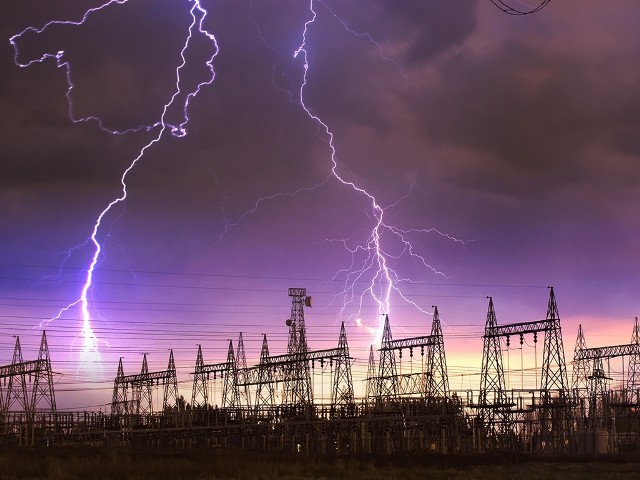
Danger of lightning
Lightning, of course, is dangerous to humans. A current of even 60 milliamps may already be fatal if, God forbid, it passes through the brain or heart. That is why lightning directly into the human body is deadly. But even if lightning strikes the ground or an object located next to a person, this is also dangerous.
Currents flowing through the earth when lightning strikes it will create a voltage drop, especially in a certain area of the earth. As a result, even between points of the earth’s surface at a distance of a meter from each other, a potential difference of hundreds or thousands of volts can occur - the so-called step voltageas the step size will be enough.
If the legs are widely spread at the moment of lightning strike, the current will pass through the human body along its legs, while the resistance of the skin of the legs and soles will determine the value of this current. Well, if rubber boots are put on your feet, then everything can do with a slight fright. And if barefoot? Then 20 volts can kill.
The only unpleasant feeling is when, not far from the place of a lightning strike, a person feels an induced charge moving through his body.
And we talked only about linear lightning, not to mention ball lightning, which can sometimes occur and quickly float in the air. Glowing electric balls (plasma) reaching 200 mm in diameter can be very dangerous.
Let’s now talk about the rules of conduct during a thunderstorm, so that in no case be struck by lightning.
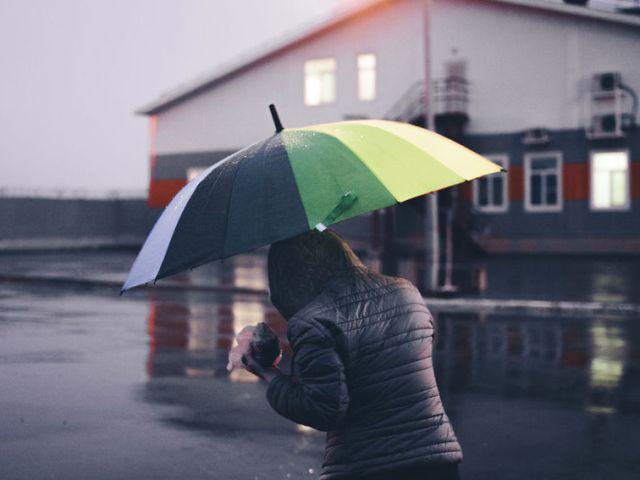
Thunderstorm Safety
-
If you are at home, close all windows and doors, as well as the chimney, if you have a stove. It is good if the residential building is equipped with a lightning rod. Rural houses often have roof antennas that need to be grounded, and it is better to forget about telephone calls during a thunderstorm.
-
When away from home, do not try to swim during a thunderstorm. Remember that water in natural reservoirs is a good conductor, especially for electric discharges.
-
Do not hide from a thunderstorm near a lonely standing tree, because it is the tops of lonely standing trees during a thunderstorm that are very electrified and literally attract lightning. Sometimes you can see how the tops of the trees glow from voltage and ionization during the approach of a thunderstorm.
-
Haystacks, pillars, and other objects protruding above the ground behave similarly. If you are in the forest, then prefer to shelter a lower tree or bush, trying, however, as carefully as possible to avoid contact with it.
-
Barefoot it is better not to walk in a thunderstorm, and especially not to lie down on the ground, remember the step voltage. When you walk in a thunderstorm on the ground, let the step be not very sweeping, put your feet not far from each other.
-
If a thunderstorm has caught you in nature, avoid the hills, and in the mountains choose the middle of the gorge for shelter. Running from place to place, remember that the time between lightning strikes is usually about 10 seconds. In the steppe for shelter it is better to use some kind of film or cloak, and just wait out the thunderstorm.
-
If you are in a boat far from the coast, for example, fishing, then you should take refuge right in it and wait out the thunderstorm, the probability of lightning strike in this case is almost zero.

Rules of conduct with ball lightning
But what if you are "lucky" and met fireball? You should not run away from it, as the stream of air will simply pull the ball lightning behind you. Calmly and slowly move away from ball lightning, watch it carefully, do not turn your back to it.
Ball lightning moves along with a stream of air, so go to that side of it, from where the wind will blow ball lightning from you. If the matter is in the room, then avoid the draft, do not stand between the window, the door and the chimney, because it is along this path that ball lightning will most likely move.
Do not try to catch the ball lightning with your hands, firstly, it is very hot, and secondly, you risk destroying it instead of using this opportunity and observing a rare natural phenomenon. No need to try to touch the ball lightning with a stick or anything else. If you are confused, then just hide away and wait until the ball lightning "discharges" or leaves the room.
If the lightning, regardless of its type, linear or ball, hit a person, and you witnessed this, then it is necessary to transfer the victim to a warm, dry, ventilated room, cover him with a blanket, and, if necessary, provide the first resuscitation measures. Urgently call an ambulance and report what happened!
See also at bgv.electricianexp.com
:
